- Macedonian Appeal To Paris, 1919-08-16!
- Sister Catherine is a good Macedonian, Time Magazine, 1933!
- Macedonia on an older map by Comberford, 1626!
- The Omaha Daily Bee,Sunday,June 20,year 1890
- A poem from my Romanian friend.
- Galveston Daily News,Galveston Texas,Friday,November 25,year 1898,Page 6
- West Coast Times,Wednesday,August 26,year 1903
- Chillicothe Constitution,April 29,year 1925,page 40880
- The Winona Daily Republican,Tuesday Evening,August 17,year 1886
- The Winchester News, December 31,year 1908
- The Washington Post,Washington,District of Columbia,Saturday,August 28,year 1909,page 2
- Winnipeg Free Press,Monday,February 10,year 1913
- Las Vegas Optic,New Mexico,Monday,November 09,year 1970,Page 2
- Chester Times,Chester Pennsylvania,October 05,year 1885
- The Brooklyn Daily Eagle-Friday,April 23,page 6,year 1897
- The Washington Post,Washington,District of Columbia,Tuesday,April 21,1908,page 27
- Las Vegas Optic,Las Vegas,New Mexico,Friday,October 14,year 1938,page 46
- The San Francisco Call,Monday,September 21,year 1903
- The Atlanta Constitution,Sunday,August 16,year 1914,page 27
- The Advocate,Ohio,April 01,year 1939,Page 3
- The Fort Wayne Sentinel,Indiana,March 08,year 1910,Page 10
- The Cedar Rapids Evening Gazette,Thursday,January 26,year 1911,Page 12
- The Indianapolis Star,Monday,January 08,year 1912,page 12
- The Mail Milford,Milford Iowa,Thursday,June 03,year 1909,Page 4
- New York Daily Tribune,September 7,year 1908
- The Fort Wayne News,Tuesday,August 19,year 1913,page 2
- The San Francisco Call,Monday,February 24,year 1903
- DOWNLOAD NEWSPAPERS
- Macedonian Folk Costumes
- Alexander the Great of Macedon
- Mark spots where heroes fell
- “A Balkan Freebooter” by Jan Gordon written in 1916.
- "The Maritime Law of Europe" in 1806
- "The Critical Review, Or, Annals of Literature" in 1770
- Charleston Daily Mail
- How the Greek differentiate the languages of the Peoples
- Newspaper documents
- On the Monastir Road-National Geographic Magazine
- Athenaeus, Deipnosophistae
- Gods Names used by the Ancient Macedonians
- What was the Mother Tongue of Alexander the Great?
- Who were the Thracians?
- Nikola Karev Interview
- Macedonian Voice - Makedonski Glas 1913-14
- Sixteen Macedonia Redux
- New York Times accounts on Illynden
- Bulgarian Document about the Macedonians
- Nostradamus on the Macedonians
- Mavro Orbini-The Kingdom of the Slavs
- History and nationalism
- Macedonian affair with the Sun
- Citations of the Ancient Macedonian Language
- Todor Aleksandrov Interview
- Jane Sandanski
- Some Quotes on Macedonia and Greece
- The Macedonian Agitation 1901
- Jane Sandanski Manifest 1908
- Macedonia - Razlovci 1876 - Kresna 1878
- Dura Europos Inscription
- Webster Dictionary 1967-69 deffinition of the IE Languages.
- Вмро Свидетелство 1933
- Thomas Gordon "History Of The Greek Revolution"
- Why not Macedonia for the Macedonians?
- Гоце Делчев
- Симеон Лехаци
- The German Slavist Wolf Oschiles
- Jordanes Getae
- The "Tavola da este" Insription
- Both the Byzantine and the Bulgarian monarchies...
- The Kings of Macedonia
- Old Persian Names
- La Macedoine et Les Macedoniens
- The Macedonians, the Greeks, and the Communists
- Димитрија Чуповски "Македонија и Македонците"
- Slaveikov on the Makedonists
- Пиринско Дело/Pirian work
- Cyril a Metod na Veľkej Morave-Slovakian View
- Cyrilo-Methodianum
- Житието на Наум/The hagiography of Naum
- Balthasar Hacquet and the Slavs
- Macedonian Polk in Ukraine
- Bulgarian Pagans slay Christians
- Bulgarian Confession
- Some more on the Name Bulgarian
- Greeks did not had any problems with the Name Macedonian back in the 80's
- Bulgarian Falsification
- G. Pulevski - Slavjano Makedonska Istorija
- Egei Makedonci Paper
- National Geographics-Greeks learn Greek
- Leopold I
- New York Times - Native Macedonians
- Isocrates Panegyricus - definition of Hellene
- From the Macedonian Knot
- Quotes on Alexander the Philhellene
- Josephus Flavius-Part I
- Confession of a Greek
- Franken had the Roman Crown
- Des Zaren Samuil
- "History of the Christian Church" Volume II Part
- Hellenism in the balkan Penisula and Asia Minor
- Macedonian fugitives in Austria
- Cups found in the Samoils fortress
- General plan of Kerr's collection of voyages and travels
- Sultan Mohamed IV letter to the Cossacks from 1675!
- Мелик Насир-ад Дин Мухамед от 1340-41 до император Андроник ІІІ Палеолог
- Macedonian Echo-Times
- Woman InThe Balkans
- The Name Macedonia forbiden by the Sultan
- Procopius of Caesarea (500 - 565 AD)
- Macedonian Emblems
- Ikonopisec: Makedonec od Selo Berovo
- Ellias Data Base and the Macedonians
- Honest Bulgarian
- Bulgarians mixed Ugri
- Giorgio Giulio Clovio Il Macedone
- Atanas Makedonec
- Bulgarians deporting Jews to Treblenka Concentration Lager
- Hondrokephalos Boulgaris
- Volga Bulgarian Links
- NY Times
- Greek view on Macedonia prior 1900
- Cyril and Methodius from Bular Site
- Thracian Language II
- Origins of the Slavs - Y chromosom
- Quotes of Philipiki - Demostenes
- Language Map prior 1912-1913
- Contemplating on λείβηθρον
- Greek Fascism
- Georgia Kastriot - Skenderbeg
- The Term Bulgarian
- United Macedonia Map 1899
- The Cult Thracian Rider and Rusalii Oro
- Balkan Forgery
- The Macedonian question - Slaveykov
- Georgia Pulevski - Trijazichnik
- Емануел Дувилард за македонскиот народ
- Anthon Hampl
- Maximilian Brandeisz
- La Federation balkanique - Весникот “Балканска Федерација
- Bulgarian striking Macedonians out of the Census
- More on the Gene Pool in the Slavic Population
- Europe's Trojans Horse
- Dispute the Greek claims
- The Saxons remains of the Macedonian heirs???
- The Present State of - Greek loss of liberty by Macedonians
- The Bee - Emathii equals Macedonia
- Реконструкција на Словенски черепи
- Факты, события, люди. В РОССИЙСКОЙ ГУСАРСКОЙ СЛУЖБЕ
- Исторические очерки. ИЗ ИСТОРИИ КУЛЬТУРНЫХ СВЯЗЕЙ ЮГОСЛАВИИ С РОССИЕЙ В XVIII ВЕКЕ
- Contemplation on the Κραββατος ethymologie
- An Armenian on the Macedonians
- Volturno Ship Disaster and the Macedonians
- From Appian's History of Rome: The Illyrian Wars
- Apeal of the Macedonians in Bulgaria
- Bulgaris vs. Bulgarian vs Vulgarism
- From Hemathia to Macedonia
- First Romanian written Document - Vlachia
- Phrygians - Brigians
- Првите наши имигранти во САД се декларирале како Македонци
- Greek Refugee Settlement
- HOW MANY VOTES FOR HUMAN RIGHTS?
- The Conquerors and the Slaves
- The Myth of Greek Ethnic 'Purity'
- The New Immigration: A Study Of The Industrial And Social Life Of The Southeastern Europeans In Amer
- Oi Polemoi 1912-1913
- Знамето на Јане Сандански
- Russian Texts on the Ancient Greek Vessel Drawings
- Bulgarian Identity crisis
- Baptizing a Bulgarian
- Greece and the Islands
- Falsifications of the leading "Historian" from the Republic of Bulgaria
- Genetic War
- Albanian hipocricy
- What's in a language?
- Who the Macedonians are
- Ethnic Macedonians self declaration
- A huge victory for Macedonia!
- Dushan law book - Macedonian Tsar
- The Travels Of Bertrandon de la Brocquiere
- Baron De Tott; Les Turcs et Les Tartares, 1784.
- Oped:Greece is saying what?
- Was it Hellenes or Greeks or maybe Roman
- Greeks vowed in front of the Bible that they will loyally translate from Macedonian
- Lectures on ancient ethnography and geography - Barthold Georg Niebuhr
- Eugene N. Borza Before Alexander
- Popolazione dell l'impero Ottomano,1911
- The Statute of the Macedonian Federative Organization
- "Greek" E3b1 contribution to Pathans of Pakistan actually Macedonian
- Philip II of Macedonia by Ian Worthington
- Macedonians found in the memoirs of Buck Whaley, 1797!
Macedonian affair with the Sun
The Royal Tomb of Vergina


Uprising Vilage Razlovci 1850



Gates of a house from 1750's :Town of Prilep


Plaoshnik the fist Slavic University

St. Mother of God Perivlepta 1290

Tepelak XVII Century Jewellery

Bridal Jewellery XVIII Galichnik

Here is a picture taken by Albert Kahn’s photographers in Macedonia. The picture is from 1912 and is one of the first in the world taken in color. Please notice the Sun symbol on the rocking bed.

Some possible reasons why the Macedonians have the connection to the Sun
Macedonia's Megalithic-era Kokino Observatory is located 1,030m above sea level on the Taticev Kamen Summit near
Kumanovo. Archaeological and astronomical analyses have shown that the observatory is more than 3,800 years old. According to NASA, which released a list ranking observatories by age, it is the
fourth oldest in the world, after Abu Simbel in Egypt, Stonehenge in Britain and Angkor Wat in Cambodia.
Kokino has incredible astronomical preciseness and has a central observation post and accessory observation posts. The observatory defines the four main positions of the Moon and three main positions
of the Sun during a year, the autumnal and vernal equinox and winter and summer solstice.One specially positioned marker shows that the observatory was also used to follow the movement of the star
cluster Pleiades.
The observatory was designed by the end of the Bronze Age and suggests a highly developed civilisation. Ancient people made their calendar with precision, with many markers and cuts in the rock and
on some places on the observatory. The observatory also helped them to determine the time for harvest and other dates.
---------------------------------------------------------------------------------------------
Another possible connection of the cult of the Sun of the Macedonians is the Sumerian Mesopotamian religion:
II. The “Sun” Symbol
This is perhaps the biggest problem with Sitchin’s interpretation of VA243 signifying the solar system. Simply put, if the central symbol in his solar system isn’t the sun, the interpretation
collapses completely. There’s actually a good deal of evidence to demonstrate decisively that Sitchin is wrong here. Toward offering that evidence, we’ll first introduce a few general comments on
Sumero-Akkadian symbols and move to the specifics.
A. General Comments
Like all ancient religions, Sumero-Mesopotamian religion had a great concern with heavenly bodies that could be observed with the naked eye. In particular, the sun, moon, and Venus were important
focus points because of their ease of visibility, and each was artistically symbolized and stood for a deity.
In Sumer-Mesopotamian religion, the sun god symbology was very clear:
Sun god = Shamash (Utu in the Sumerian languagee)

The symbol of the sun in Sumero-Mesopotamian religion was a central circle with four extended “arms” with wavy lines in between each “arm” (most common), or a circle with only wavy lines. The entire symbol was itself nearly always [I don’t know any exceptions, but there may be one – just being cautious here] inside a circle, as right:f
The reader should note immediately that this is NOT the symbol on VA243. VA 243’s “pseudo-sun” lacks the wavy lines and is not set inside a circle.
This sun symbol is ubiquitous in Sumero-Mesopotamian religious artwork. The other common symbol for the sun god was the god in flight upon a set of wings (a depiction akin to the winged disc in Egyptian religion).
The above classic solar disk iconography in Sumero-Mesopotamian religion is contrasted with the star symbol, used to symbolize either stars in constellations, any deity (the star is either over the deity’s head or above it to the left of right), or Ishtar (Sumerian Inana), who stood for Venus, the most visible object in the sky aside from the sun and moon:g
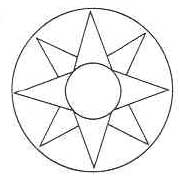 Note that this example has eight points. This is the
most frequently attested style in Sumero-Mesopotamian religious art. The star also is found with six (like VA 243) or seven points, and the points even vary within the same seal or stela carving. It
wasn’t consistent in points, but what the symbol stood for was consistent – either a star, planet, or deity – but NOT the sun. The star symbol is either set within a circle or, far more often, not
within a circle. It is clearly distinct from the sun symbol.
Note that this example has eight points. This is the
most frequently attested style in Sumero-Mesopotamian religious art. The star also is found with six (like VA 243) or seven points, and the points even vary within the same seal or stela carving. It
wasn’t consistent in points, but what the symbol stood for was consistent – either a star, planet, or deity – but NOT the sun. The star symbol is either set within a circle or, far more often, not
within a circle. It is clearly distinct from the sun symbol.
How do I know that the symbol of VA 243 is a star and not the sun disk? Other than the obvious noted above – that VA 243 does not have the wavy lines between the “arms” of the symbol and is not set within a circle - Sumero-Mesopotamian religion often grouped the symbols for the sun god with that of the moon god (Akkadian = Sin; Sumerian = Nanna) and Ishtar (Sumerian = Inana). This isn’t surprising since they were so readily viewed. In short, they didn’t confuse the symbols and neither should we.
This grouped threesome is very prevalent in Sumero-Mesopotamian art, and compels the observation that the sun symbol and star symbol were distinguished from each other:

Source: Ursula Seidl, Die Babylonischen Kudurru Reliefs, Tafel 11, Zweite Gruppe, stela “a” = The Babylonian Kudurru Reliefs, Plate 11, 2nd Group, stela “a”. Note the wavy lines and encircled sun symbol on the right.

Ursula Seidl, Die Babylonischen Kudurru Reliefs, Tafel 19, Vierte Gruppe, stela “b” = The Babylonian Kudurru Reliefs, Plate 19, 4th Group, relief “b”. Note the wavy lines and encircled sun symbol on the lower right.
The symbols for sun and star/planet are also distinguished clearly in zodiacal artwork from Mesopotamia:
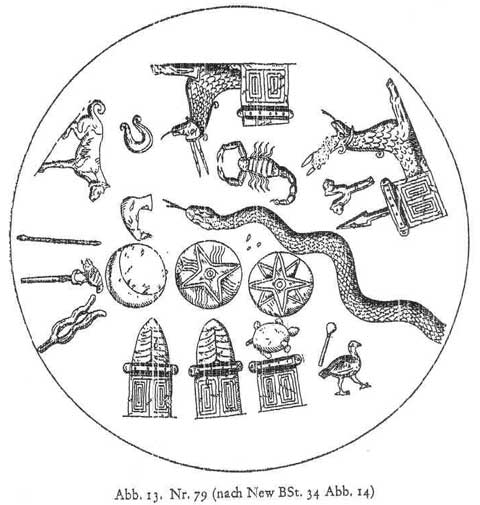
Source: Ursula Seidl, Die Babylonischen Kudurru Reliefs, p. 47 = The Babylonian Kudurru Reliefs, p. 47
The sun symbol (Left) and star symbol (Right) are next to each other under the snake (Draco). Note the wavy lines of the sun symbol
Here is a close-up of the sun (L) and star (R) symbol above. Note that the star in this case has eight points:
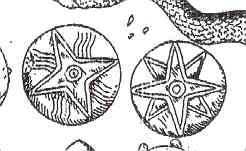
A second zodiac example:
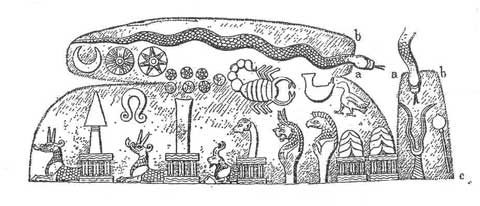
Source: Ursula Seidl, Die Babylonischen Kudurru Reliefs, p. 60 = The Babylonian Kudurru Reliefs, p. 60
The sun symbol (center) and star symbol (R of center) are next to each other under the snake’s tail. Note the wavy lines of the sun symbol
In the above example, note that: (1) the star has seven points, and (b) the stars below it have six points. Note also that these smaller stars also LACK points – they are just dots. This seven dot/circle arrangement is one of the most common motifs in Mesopotamian art, and denote the Pleiades.
The point here is that dots = stars in Mesopotamian art when in an astronomical context (or a context where a deity is identified with a star). This is important for our consideration of VA 243.
Again, here is a close-up:

A third zodiac example:
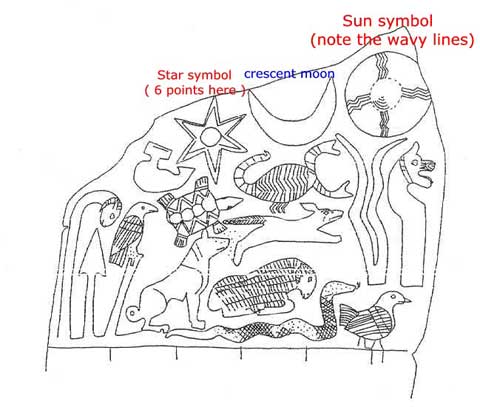
Source: Ursula Seidl, Die Babylonischen Kudurru Reliefs, p. 23 = The Babylonian Kudurru Reliefs, p. 23
Note that the star symbol here has six points as does the VA 243 star.
Some commentary on this last example is in order. The previous two examples clearly are in zodiac context, as is this one. Those previous two examples clearly have the sun symbol drawn in a manner consistent with expected Sumero-Mesopotamian features (wavy lines, encircled) that unmistakably distinguishes the sun from the star symbol. The star symbol signifies the same astronomical body in each case, yet the number of points varies. This means that the number of points is unimportant for identifying the star symbol as a STAR or planet, NOT the sun. Hence one cannot say, “well the star symbol usually has eight points, and the Sitchin seal has six, therefore it’s not a star but the sun.” This is erroneous because these examples demonstrate clearly that a star symbol can have 6, 7, or 8 pts., and LACKS wavy lines. The symbol on Sitchin’s VA 243 is NOT the sun. It is a star, and thus denotes a star, a god, or a single planet. This isn’t my opinion, it’s the Sumero-Mesopotamian art convention.
Please note that this article continues discussing cylinder seal examples of star symbols: sitchiniswrong
